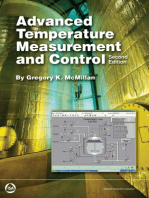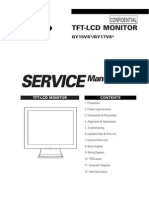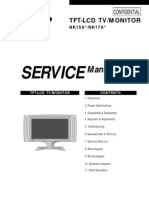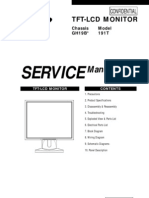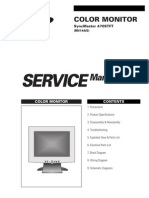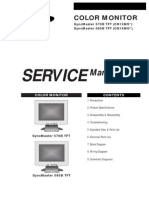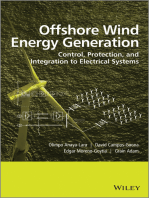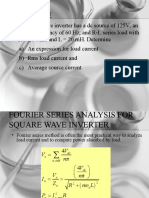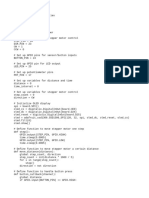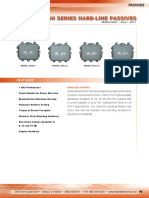Sddjf1A: Slim Type Single Pole Rocker Power Switch
Sddjf1A: Slim Type Single Pole Rocker Power Switch
Uploaded by
shyhuCopyright:
Available Formats
Sddjf1A: Slim Type Single Pole Rocker Power Switch
Sddjf1A: Slim Type Single Pole Rocker Power Switch
Uploaded by
shyhuOriginal Description:
Original Title
Copyright
Available Formats
Share this document
Did you find this document useful?
Is this content inappropriate?
Copyright:
Available Formats
Sddjf1A: Slim Type Single Pole Rocker Power Switch
Sddjf1A: Slim Type Single Pole Rocker Power Switch
Uploaded by
shyhuCopyright:
Available Formats
208
Detector
Rotary
Encoders
Power
Dual-in-line
Package Type
TACT Switch
TM
Push
Slide
Rocker
Type
Rotary
Type
Push
Type
Slide
Type
Style(ON position)
Dimensions Unit:mm
Circuit Diagram
6
.
8
1
5
2
4
.
6
Terminal No.
Plating
Travel
5.2
3.1
5.6
6
Can be used
tab terminal #187
Terminal No.
15
4.75 4.75
No plating
16 14.5
25
Packing Specifications
Bulk
750 150
Number of packagespcs.)
400 270 290
Export
package
measurements
mm)
1 case / Japan
1 case /
export packing
Circuit
arrangement
Operating
force
Mounting
method
Product No.
SPST 3 2N
Travel
mm)
4.6
Terminal
configuration
For Lead Snap-in
Marking
Knob)
Export Japan
Minimum order unit pcs.)
750 150 SDDJF1A100
Product Line
without
SDDJF1A
SIim Type SinyIe PoIe Rocker Power Switch
Industry's thinnest with a 5.2mm body width.
QRatings and Safety Standards
Items Specifications
SEMKOENEC)
106 / 250
8A / 128A250V
Refer to P.215 for soldering conditions.
Power Switches
197
Detector
Rotary
Encoders
Power
Dual-in-line
Package Type
TACT Switch
TM
Slide
Push
Rotary
Type
Push
Type
Rocker
Type
Slide
Type
Slide
Push
Type Rocker Slide
Rotary
Series SDDJF1A SDKP SDKT SDKZ SDDE
Photo
Rating
8A / 128A 250V
10(6) / 250
5A 250V AC 6A 125V AC
PS:166)A 250V AC
146)A 250V AC
AC Switch : 1A / 16A 250V
DC Switch : 20mA 12V DC
DC:0.1A 12V DC Encoders: 0.1A 12V DC
Operating life
10,000cycles 1,000cycles 20,000cycles
10,000cyclesPower)
AC Switch : 10,000 cycles
DC Switch : 10,000 cycles
30,000cycles Encoder)
10A 250V AC Without load 6A 125V AC
16A 250V ACPower)
0.1A 12V DCEncoder)
Encoder
30,000 cycles
Travelmm) 4.6 6 2.2 Endless
Push Switches: 1.85mm
Encoders: 360360Rotation)
Features
With Encoders
circuit
ACSwitch , DCSwitch ,
With Encoder
Operating temperature
range
10T to 55T 10T to 60T 10T to 70T 0T to 85T
Automotive use _
Life cycle (availability)
Electrical
performance
Contact
resistance
100mO max. 10mO max.
100mO max. Power) AC Switch : 100mO max.
DC Switch: 500mO max.
Encode: 1O max. 1O max. Encoder)
Insulation
resistance
500MO min. 500V DC
1,000MO min.
500V DC
500MO min. 500V DC
Power)
AC Switch : 100MO min. 500V DC
DC Switch : 100MO min. 100V DC
Encoder: 100MO min. 100V DC
100MO min. 100V DC
Encoder)
Voltage
proof
2,000V AC for 1minute
1,000V AC
for 1minute
2,000V AC for 1minute
Power)
AC Switch: 2,000V AC for 1 minute
DC Switch: 100V AC for 1 minute
Encode: 100V AC for 1 minute
100V AC for 1minute
Encoder)
Mechanical
performance
Terminal
strength
50N for 1minute 10N for 1minute
20NPower)
AC Switch: 5N for 1 minute
DC Switch: 5N for 30s
Encode: 5N for 1 minute
5NEncoder)
Actuator
strength
Operating
direction
25N 50N 30N 100N
Perpendicular
direction
25N 50N 10N 30N
30N
(retract direction)
Environmental
performance
Cold 202T for 96h 402T for 240h
Dry heat 852T for 96h 852T for 240h
Damp heat 402T, 90to95%RH for 96h 402T, 90to95%RH for 240h
Page 208 209 210 211 214
Power Switches So|dering Oonditions 215
Power Switches Oautions 215
Power Switches Safety Standard 215
Note _ indicates applicability to some products in the series.
Q List of Varieties
215
Detector
Rotary
Encoders
Power
Dual-in-line
Package Type
TACT Switch
TM
Slide
Push
Rotary
Type
Push
Type
Rocker
Type
Slide
Type
Power Switches Soldering Conditions
SDDJE, SDDJF, SDKP,
SDDJF1A , SDKZ, SDDE
SDKT
SDKR
35010
35010
30010
31 / 0s
30.5s
30.5s
Series
Soldering
temperature
Soldering time
Reference for Hand Soldering Reference for Dip Soldering
(For PO board termina| types and SDDJF right-
ang|e termina| types)
SDKR, SDDJE, SDDJF,
SDKP, SDKT, SDKZ, SDDE
2605 101s
Series
Dip soldering
Soldering
temperature
Duration of
immersion
Power Switches Cautions
Power Switches Safety Standards
1. The primary power supply switching is subject to the safety regulations, and the provisions differ by
each destination. Consult with us for non-standard use cases.
2. An unstable contact may occur if the switch current is lower than 0.5A. For this case, consult with us.
3. These power switches were produced for alternating current. For direct current, consult with us.
4. Appling load to terminals during soldering under certain conditions may cause deformation and
electrical property degradation.
5. Avoid use of water-soluble soldering flux, since it may corrode the switches.
6. When soldering twice, wait until the first soldered portion cools to normal temperature. Continuous
heating will deform the external portions, loosen or dislodge terminals, or may deteriorate their
electrical characteristics.
7. Before soldering switches with locking mechanism, release the locks. If they are soldered without
releasing the locks, the soldering heat may deform the locking mechanism.
8. Be sure to release the locks before removing the knobs. Otherwise, the locking mechanism may be
broken.
9. Be sure to use the switch with forced travel positioned as close to the total travel as possible.
10. Tighten the mounting screws by applying the specified torque. Tightening with a larger torque than
the specified will result in malfunction or breakage of screws.
11. Corrosive gas if generated by peripheral parts of a set, malfunction such as imperfect contact may
occur. Thorough investigation shall be required beforehand.
12. Storage
1 Store the products as delivered, at a normal temperature and humidity, without direct sunshine
and corrosive gas ambient. Use them at an earliest possible timing, not later than six months
upon receipt.
2 After breaking the seal, keep the products in a plastic bag to shut out ambient air, store them in the
same environment as above, and use them up as soon as possible.
3Do not stack too many switches.
1. Safety Standards Outline
Safety standards are established by a country or an organization representing it to protect general
users from electrical shock and fire hazards. It establishes standards for electrical devices and
components. For electrical equipment manufacturers, utilizing switches that have been safety-
approved ensures the safety of the switch. The use of a safety-approved switch also simplifies at
least one part of the process of obtaining certification by safety testing.
2. Major Safety Standards
1)Electrical Appliance and Material Safety Law
The conventional [Electrical Appliance and Material Control Law] has changed to [Electrical Appliance
and Material Safety Law] and has been enforced since April 1, 2001. Electrical appliances are
categorized into special electric appliances and partsformerly Class Aand Electrical appliances other
than the special electric appliances formerly Class B. Special electric appliances are required to
receive goodness of fit test at a certified test agency and to store the certificate. Also, penal provisions
have been reinforced.
2)ULUnderwriters Laboratories Inc.)
Underwriters Laboratories Inc. ULis the American safety approving organization. Its purpose is to
ensure consumer safety and protect them from fire hazards. State law requires that equipment to
be exported to the United States utilize UL approved power switches or power switches meeting UL
standards and capable of passing UL tests.
You might also like
- Advanced Temperature Measurement and Control, Second EditionFrom EverandAdvanced Temperature Measurement and Control, Second EditionNo ratings yet
- Hitachi Rac-14eh1 Ras-14eh1 (ET)Document93 pagesHitachi Rac-14eh1 Ras-14eh1 (ET)peterdodov100% (1)
- Hitachi Manual RAS - RAC-18-25YH6Document95 pagesHitachi Manual RAS - RAC-18-25YH6Yashika Arora100% (3)
- Industrial Applications of Infrared Thermography: How Infrared Analysis Can be Used to Improve Equipment InspectionFrom EverandIndustrial Applications of Infrared Thermography: How Infrared Analysis Can be Used to Improve Equipment InspectionRating: 4.5 out of 5 stars4.5/5 (3)
- Electrolyser Failure Analysis Report by Titan PDFDocument19 pagesElectrolyser Failure Analysis Report by Titan PDFrob.carey100% (1)
- Water-Proof Switch Compatible With 10ma To 4.5A: IP68 Water Resistant, Enabling Submerged OperationDocument3 pagesWater-Proof Switch Compatible With 10ma To 4.5A: IP68 Water Resistant, Enabling Submerged OperationshyhuNo ratings yet
- 0.5A 125V AC Qualified TypeDocument4 pages0.5A 125V AC Qualified TypeshyhuNo ratings yet
- Water-Proof Type With Built-In Detector SwitchesDocument3 pagesWater-Proof Type With Built-In Detector SwitchesshyhuNo ratings yet
- SDDJF: 16A 250V AC Qualified TypeDocument4 pagesSDDJF: 16A 250V AC Qualified TypeshyhuNo ratings yet
- Sddje: 10A 250V AC Qualified TypeDocument6 pagesSddje: 10A 250V AC Qualified TypeshyhuNo ratings yet
- SAMSUNG LCD Service Manual (Internal) - ES15UDocument81 pagesSAMSUNG LCD Service Manual (Internal) - ES15Umeng798651No ratings yet
- SAMSUNG LCD Service Manual Internal) - ES15UDocument81 pagesSAMSUNG LCD Service Manual Internal) - ES15Uqwerzwill905560No ratings yet
- Samsung GY15VS GY17VS Service ManualDocument52 pagesSamsung GY15VS GY17VS Service ManualdanishadvanceNo ratings yet
- Panasonic TC-22LR30 LCDDocument62 pagesPanasonic TC-22LR30 LCDngoclinhdtddNo ratings yet
- Samsung LW17N13WRDocument59 pagesSamsung LW17N13WROleg IvolNo ratings yet
- Hitachi 0539e (Rak 50 Ppa Wpa) Rev01Document116 pagesHitachi 0539e (Rak 50 Ppa Wpa) Rev01Emil Tashev100% (2)
- User Manual IEC Micromax MicromaxRF OM3590Document20 pagesUser Manual IEC Micromax MicromaxRF OM3590masroork_2No ratings yet
- Samsung LCD Ltm295wxDocument89 pagesSamsung LCD Ltm295wxparis68No ratings yet
- Samsung Gh19bsDocument42 pagesSamsung Gh19bsalgjocNo ratings yet
- 7580654-Lg Rc288 VCR DVD Recorder Service ManualDocument161 pages7580654-Lg Rc288 VCR DVD Recorder Service ManualHarvey Benson0% (1)
- Service: ManualDocument31 pagesService: ManualsumidinNo ratings yet
- Samsung LS15N13WDocument65 pagesSamsung LS15N13WmiltoncgNo ratings yet
- HS 2250FCR PDFDocument24 pagesHS 2250FCR PDFhectormarioguzmiNo ratings yet
- PXV4 ManualDocument25 pagesPXV4 ManualduyphuocNo ratings yet
- 42 799Document12 pages42 799scribdkhatnNo ratings yet
- Samsung Syncmaster 570B TFTDocument38 pagesSamsung Syncmaster 570B TFTinvisiblevision4No ratings yet
- JVC mx-gt80 gt90 SM No-Sch (ET)Document48 pagesJVC mx-gt80 gt90 SM No-Sch (ET)Cliffton FilipinoPrd ShraderNo ratings yet
- Samsung S19a300b S19a300n S20a300b S20a300n S22a300b S23a300b S24a300b S24a300bl Chassis wdm1 LCDocument41 pagesSamsung S19a300b S19a300n S20a300b S20a300n S22a300b S23a300b S24a300b S24a300bl Chassis wdm1 LCMocanu RaduNo ratings yet
- Panasonic Sa Akx14pDocument34 pagesPanasonic Sa Akx14plondon335No ratings yet
- Dvd-Video Player: Service ManualDocument47 pagesDvd-Video Player: Service ManualAnonymous YL2E8yWGNo ratings yet
- Service: ManualDocument32 pagesService: Manualtodd956No ratings yet
- Syncmaster 510N 710N 910N PDFDocument48 pagesSyncmaster 510N 710N 910N PDFsupriyo110No ratings yet
- LG lrm-519 (ET)Document158 pagesLG lrm-519 (ET)joeblow44No ratings yet
- Manual Servico Mini System Samsung Max g55td XazDocument70 pagesManual Servico Mini System Samsung Max g55td XazAntonio CunhaNo ratings yet
- HITACHI RAC-E08H2 - RAC-E10H2 - RAS-E08H2A - RAS-E10h2A PDFDocument95 pagesHITACHI RAC-E08H2 - RAC-E10H2 - RAS-E08H2A - RAS-E10h2A PDFPuiu Frasi GrNo ratings yet
- LG L194WTDocument29 pagesLG L194WTqxbgwhvuNo ratings yet
- 8516902-Panasonic Hdc-Sd5 Series Service Manual Repair GuideDocument79 pages8516902-Panasonic Hdc-Sd5 Series Service Manual Repair Guidekdm004No ratings yet
- Mitsubishi S500E VFD Basic ManualDocument79 pagesMitsubishi S500E VFD Basic ManualPuvan80No ratings yet
- Electrical Installation Tester: Safety InformationDocument5 pagesElectrical Installation Tester: Safety InformationKhaled BellegdyNo ratings yet
- Ras-25 - 35FH5 Rac25-35yh5Document95 pagesRas-25 - 35FH5 Rac25-35yh5masinemaNo ratings yet
- CT720g S774AAR5S2NCDocument45 pagesCT720g S774AAR5S2NCAnonymous CJnGHNNo ratings yet
- Service: LCD-TVDocument70 pagesService: LCD-TVRobert VojakNo ratings yet
- Manual Variador de Frecuencia Vfs 11 ToshibaDocument256 pagesManual Variador de Frecuencia Vfs 11 ToshibaWilber Calloapaza Flores100% (1)
- HT P1200Document4 pagesHT P1200vantuyetphamNo ratings yet
- Samsung SyncMaster 913NDocument56 pagesSamsung SyncMaster 913NddaaggNo ratings yet
- Inverter FR-A800 Installation GuidelineDocument82 pagesInverter FR-A800 Installation Guidelineprsking187No ratings yet
- NXT4 Bia e 1Document24 pagesNXT4 Bia e 1Felipe AchurraNo ratings yet
- Introduction to Power System ProtectionFrom EverandIntroduction to Power System ProtectionRating: 5 out of 5 stars5/5 (1)
- Analog Dialogue Volume 46, Number 1: Analog Dialogue, #5From EverandAnalog Dialogue Volume 46, Number 1: Analog Dialogue, #5Rating: 5 out of 5 stars5/5 (1)
- Offshore Wind Energy Generation: Control, Protection, and Integration to Electrical SystemsFrom EverandOffshore Wind Energy Generation: Control, Protection, and Integration to Electrical SystemsNo ratings yet
- Chainsaw Operator's Manual: Chainsaw Safety, Maintenance and Cross-cutting TechniquesFrom EverandChainsaw Operator's Manual: Chainsaw Safety, Maintenance and Cross-cutting TechniquesRating: 5 out of 5 stars5/5 (1)
- Fundamental Elements of Applied Superconductivity in Electrical EngineeringFrom EverandFundamental Elements of Applied Superconductivity in Electrical EngineeringNo ratings yet
- On-Chip Electro-Static Discharge (ESD) Protection for Radio-Frequency Integrated CircuitsFrom EverandOn-Chip Electro-Static Discharge (ESD) Protection for Radio-Frequency Integrated CircuitsNo ratings yet
- Ultrasound Analysis for Condition Monitoring: Applications of Ultrasound Detection for Various Industrial EquipmentFrom EverandUltrasound Analysis for Condition Monitoring: Applications of Ultrasound Detection for Various Industrial EquipmentRating: 4.5 out of 5 stars4.5/5 (3)
- RDC40 RDC50 RDC90: Rotary TypeDocument6 pagesRDC40 RDC50 RDC90: Rotary TypeshyhuNo ratings yet
- RD6R1A: Rotary Type CustomDocument4 pagesRD6R1A: Rotary Type CustomshyhuNo ratings yet
- Linear Type: The High Accuracy Space Saving Design Contributes To Reduced Weight and Size of SetsDocument5 pagesLinear Type: The High Accuracy Space Saving Design Contributes To Reduced Weight and Size of SetsshyhuNo ratings yet
- Hollow-Shaft Type That Enables Output Covering The Whole 360-Degree Angle Due To Adoption of 2-Phase OutputDocument4 pagesHollow-Shaft Type That Enables Output Covering The Whole 360-Degree Angle Due To Adoption of 2-Phase OutputshyhuNo ratings yet
- 3.5×3.2mm Low-Profile Double Action Type (Surface Mount Type)Document3 pages3.5×3.2mm Low-Profile Double Action Type (Surface Mount Type)shyhuNo ratings yet
- List of Varieties: Resistive Position SensorsDocument1 pageList of Varieties: Resistive Position SensorsshyhuNo ratings yet
- Linear Type Exclusively Used To Detect The Angle of Vehicle Head LightsDocument5 pagesLinear Type Exclusively Used To Detect The Angle of Vehicle Head LightsshyhuNo ratings yet
- List of Varieties: Detector Slide Push RotaryDocument5 pagesList of Varieties: Detector Slide Push RotaryshyhuNo ratings yet
- 0.6mm Low-Profile, Double Action TypeDocument3 pages0.6mm Low-Profile, Double Action TypeshyhuNo ratings yet
- 4.3×2.2mm Compact Low-Profile Double Action Surface Mount TypeDocument3 pages4.3×2.2mm Compact Low-Profile Double Action Surface Mount TypeshyhuNo ratings yet
- 6.1 × 3.7mm Compact High-Speed Mounting (Surface Mount Type)Document3 pages6.1 × 3.7mm Compact High-Speed Mounting (Surface Mount Type)shyhuNo ratings yet
- 6.2mm Square With Middle-Travel (Surface Mount Type) : Rubber Stem Helps To Achieve Travel of 0.3 To 0.55mm & Over TravelDocument3 pages6.2mm Square With Middle-Travel (Surface Mount Type) : Rubber Stem Helps To Achieve Travel of 0.3 To 0.55mm & Over TravelshyhuNo ratings yet
- Tall Height (4.3mm and 5.0mm) and Surface Mount TypeDocument3 pagesTall Height (4.3mm and 5.0mm) and Surface Mount TypeshyhuNo ratings yet
- Quiet Type With 0.9mm Stroke (Surface Mount Type)Document3 pagesQuiet Type With 0.9mm Stroke (Surface Mount Type)shyhuNo ratings yet
- 5.2mm Square Low-Profile (Surface Mount Type)Document4 pages5.2mm Square Low-Profile (Surface Mount Type)shyhuNo ratings yet
- Quiet Middle-Stroke (Surface Mount Type) : Switch With 0.7mm Stroke Achieving Both Quiet Operation and An Excellent FeelDocument3 pagesQuiet Middle-Stroke (Surface Mount Type) : Switch With 0.7mm Stroke Achieving Both Quiet Operation and An Excellent FeelshyhuNo ratings yet
- 6.2 × 6.3mm (Surface Mount Type) : A Wide Variety of Products Including Dust-Proof TypeDocument4 pages6.2 × 6.3mm (Surface Mount Type) : A Wide Variety of Products Including Dust-Proof TypeshyhuNo ratings yet
- Side Push Surface Mount Type With 1.55mm Height SKTD SeriesDocument3 pagesSide Push Surface Mount Type With 1.55mm Height SKTD SeriesshyhuNo ratings yet
- Side Push Half-Mount Type With 1.6mm Height (Surface Mount Type)Document3 pagesSide Push Half-Mount Type With 1.6mm Height (Surface Mount Type)shyhuNo ratings yet
- Total Hight of 3.1mm. Surface Mount Package With Ground TerminalDocument3 pagesTotal Hight of 3.1mm. Surface Mount Package With Ground TerminalshyhuNo ratings yet
- 12mm Square (Snap-In Type) : Joint Stem & Flat Stem With Stable Operation FeelingDocument4 pages12mm Square (Snap-In Type) : Joint Stem & Flat Stem With Stable Operation FeelingshyhuNo ratings yet
- 4.5×3.55mm Side Push Type (Surface Mount Type) : Sidepush With High Solder Strength & Tactile FeelingDocument3 pages4.5×3.55mm Side Push Type (Surface Mount Type) : Sidepush With High Solder Strength & Tactile FeelingshyhuNo ratings yet
- 12mm Square Long-Life (Snap-In Type) : Long-Life Type With Unique Dust-Proof Structure and Highly Reliable Metal ContactsDocument4 pages12mm Square Long-Life (Snap-In Type) : Long-Life Type With Unique Dust-Proof Structure and Highly Reliable Metal ContactsshyhuNo ratings yet
- Side Push Mid-Mount Type With 1.35mm Height (Surface Mount Type)Document3 pagesSide Push Mid-Mount Type With 1.35mm Height (Surface Mount Type)shyhuNo ratings yet
- 10mm Square Water-Proof (Snap-In Type)Document5 pages10mm Square Water-Proof (Snap-In Type)shyhuNo ratings yet
- 6.6mm Square (Snap-In Type) : Dust Proof With Sharp Operational Feel Suitable For General PurposeDocument5 pages6.6mm Square (Snap-In Type) : Dust Proof With Sharp Operational Feel Suitable For General PurposeshyhuNo ratings yet
- 1.25mm Height Low-Profile Side Push Surface Mount TypeDocument3 pages1.25mm Height Low-Profile Side Push Surface Mount TypeshyhuNo ratings yet
- 6mm Square Dust-Proof (Snap-In Type)Document3 pages6mm Square Dust-Proof (Snap-In Type)shyhuNo ratings yet
- 6mm Square (Snap-In Type)Document6 pages6mm Square (Snap-In Type)shyhuNo ratings yet
- 6×3.5mm Compact (Snap-In Type) : Switch Contributing To High-Density Mounting, Available With Top or Side Push OperationDocument4 pages6×3.5mm Compact (Snap-In Type) : Switch Contributing To High-Density Mounting, Available With Top or Side Push OperationshyhuNo ratings yet
- Ethernet Intelligent Pressure Scanner: Netscanner™ SystemDocument8 pagesEthernet Intelligent Pressure Scanner: Netscanner™ SystemljboorNo ratings yet
- SN 74 LVC 2 G 32Document26 pagesSN 74 LVC 2 G 32Kartik ShuklaNo ratings yet
- APRCETDocument3 pagesAPRCETManu ManuNo ratings yet
- Ads 1256Document43 pagesAds 1256yaser2005100% (2)
- Sungrow-SG3 0RT-SG4 0RTDocument2 pagesSungrow-SG3 0RT-SG4 0RTchris dascalopoulosNo ratings yet
- Solution InverterDocument12 pagesSolution Inverterxuanbac1984No ratings yet
- Currency Counting Machine: Intelligent, High Quality Counter With Enhanced Counterfeit DetectionDocument2 pagesCurrency Counting Machine: Intelligent, High Quality Counter With Enhanced Counterfeit DetectionsoareswalsonNo ratings yet
- Xilinx FPGA Demo Board DescriptionDocument8 pagesXilinx FPGA Demo Board DescriptionTa Duy Linh0% (1)
- Installation Manual ML-501: I. Accessory Parts (Fax Multi Line) (Fax Kit)Document6 pagesInstallation Manual ML-501: I. Accessory Parts (Fax Multi Line) (Fax Kit)hashemNo ratings yet
- Soldering NotesDocument7 pagesSoldering NotesAlfred Galea100% (1)
- DD Lab Expt 2Document9 pagesDD Lab Expt 2Umang goelNo ratings yet
- Ac 150Document5 pagesAc 150Ricardo Dias100% (1)
- 07 Galvanometer - 2Document2 pages07 Galvanometer - 2Muhammad SufyanNo ratings yet
- Schleifen Code Mit DisplayDocument3 pagesSchleifen Code Mit DisplayMarco989898PlaysNo ratings yet
- Utt NotesDocument82 pagesUtt NotesDenzil D'SouzaNo ratings yet
- Universal Slice Applicators Data SheetDocument2 pagesUniversal Slice Applicators Data SheetNordson Adhesive Dispensing SystemsNo ratings yet
- Smart Home Based On Iot Using SSR: SwitchesDocument15 pagesSmart Home Based On Iot Using SSR: SwitchesPriyankanNo ratings yet
- Disclosure To Promote The Right To InformationDocument20 pagesDisclosure To Promote The Right To InformationTheodor Eike100% (1)
- Star Auto-Evaluation Report: Project: Location: Contract: Engineer: Filename: DateDocument5 pagesStar Auto-Evaluation Report: Project: Location: Contract: Engineer: Filename: DateAndres VergaraNo ratings yet
- BGD 500-S Automatic Digital Pull-Off Adhesion TesterDocument2 pagesBGD 500-S Automatic Digital Pull-Off Adhesion TesterNguyễn Xuân NamNo ratings yet
- Presented By:-Ayushi Srivastava Iii Yr Mechanical EngineeringDocument25 pagesPresented By:-Ayushi Srivastava Iii Yr Mechanical Engineeringashishgoel102No ratings yet
- PROTON - Three Phase Voltage Monitoring Relay - VMR 3P: Salient FeaturesDocument1 pagePROTON - Three Phase Voltage Monitoring Relay - VMR 3P: Salient FeaturesMohsin JalgaonkarNo ratings yet
- User's Guide: Downloaded From Manuals Search EngineDocument372 pagesUser's Guide: Downloaded From Manuals Search EnginecesNo ratings yet
- Gas Turbine InstrumentationDocument62 pagesGas Turbine InstrumentationGnanaseharan Arunachalam100% (5)
- Hoja de Datos Acoplador DireccionalDocument2 pagesHoja de Datos Acoplador DireccionalDuvanChalaNo ratings yet
- Card Reading Accessories: Tps900 Eft PosDocument2 pagesCard Reading Accessories: Tps900 Eft PosEris Osman RifkiNo ratings yet
- Guangdong Fenghua Advanced Tech 0805CG220J500NT C24658Document27 pagesGuangdong Fenghua Advanced Tech 0805CG220J500NT C24658ramsringarNo ratings yet
- (J. R. James) Handbook of Microstrip Antennas (BookFi)Document670 pages(J. R. James) Handbook of Microstrip Antennas (BookFi)sarah_manafiNo ratings yet
